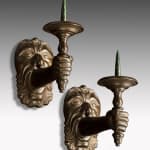Pair of 17th Century German Baroque Bronze Wall Lights
7 ½ x 4 ¼ x 9 ¾ in
Further images
Provenance
Private Collection, Paris.
Sand cast bronze; each in the form of an outstretched human arm emerging from the mouth of a Green Man – a ‘grotesque’ style face.
The ‘Green Man’: is a carving, drawing, or other representation of a face – generally male – surrounded by or made from leaves. Branches or vines may sprout from the nose, mouth, nostrils or other parts of the face, sometimes called a ‘disgorging’ or ‘uttering’ head. The hair can also be made from leaves, as in the foliage which emanates from the bridge of the nose and over the forehead in our pair of wall lights. Commonly used as a decorative architectural ornament, the Green Man is frequently found in carvings on both secular and ecclesiastical buildings.
However, there is no common standard representation of a Green Man, and the symbolism of the motif remains elusive as many variations can be found in cultures around the world, although often related to natural woodland deities. The Green Man appears in a variety of guises and moods. However, the most common interpretation of the Green Man is that of a pagan nature spirit, a symbol of man’s reliance on and union with nature, primarily interpreted as symbolising rebirth and the renewed cycle of growth each spring.
Flemish Mask Designs in the Grotesque Style: One of the source materials for the Green Man is the Flemish ‘grotesque’. In 1555, the Flemish engraver Frans Huys produced a series of designs for masks rooted in the ‘grotesque’ style, which were used for a design manual. This ‘grotesque’ style of decorative art was derived from ancient Roman prototypes and was characterised by the combination of fantastical human and animal forms with foliage or vegetative forms, creating a style which later became known as ‘auricular’. Huys based this set of prints on original designs by the sculptor and architect Cornelis Floris (1514-1575), who is credited with inventing a Flemish version of the grotesque style in about 1541. The print illustrated (see Further Images) comes from a set by Huys, published in 1555 by Hans Liefrinck, an important Antwerp publisher and print-seller. It is believed that the volume, entitled ‘Pourtraicture ingenieuse de plusieurs façons de Masques, forts utile aulx painctres, orseures, taillieurs de pierres, voirriers, & tailleurs d’images’, contained a set of 18 prints and was intended as a sourcebook for craftsmen and artists looking for inspiration or templates.








